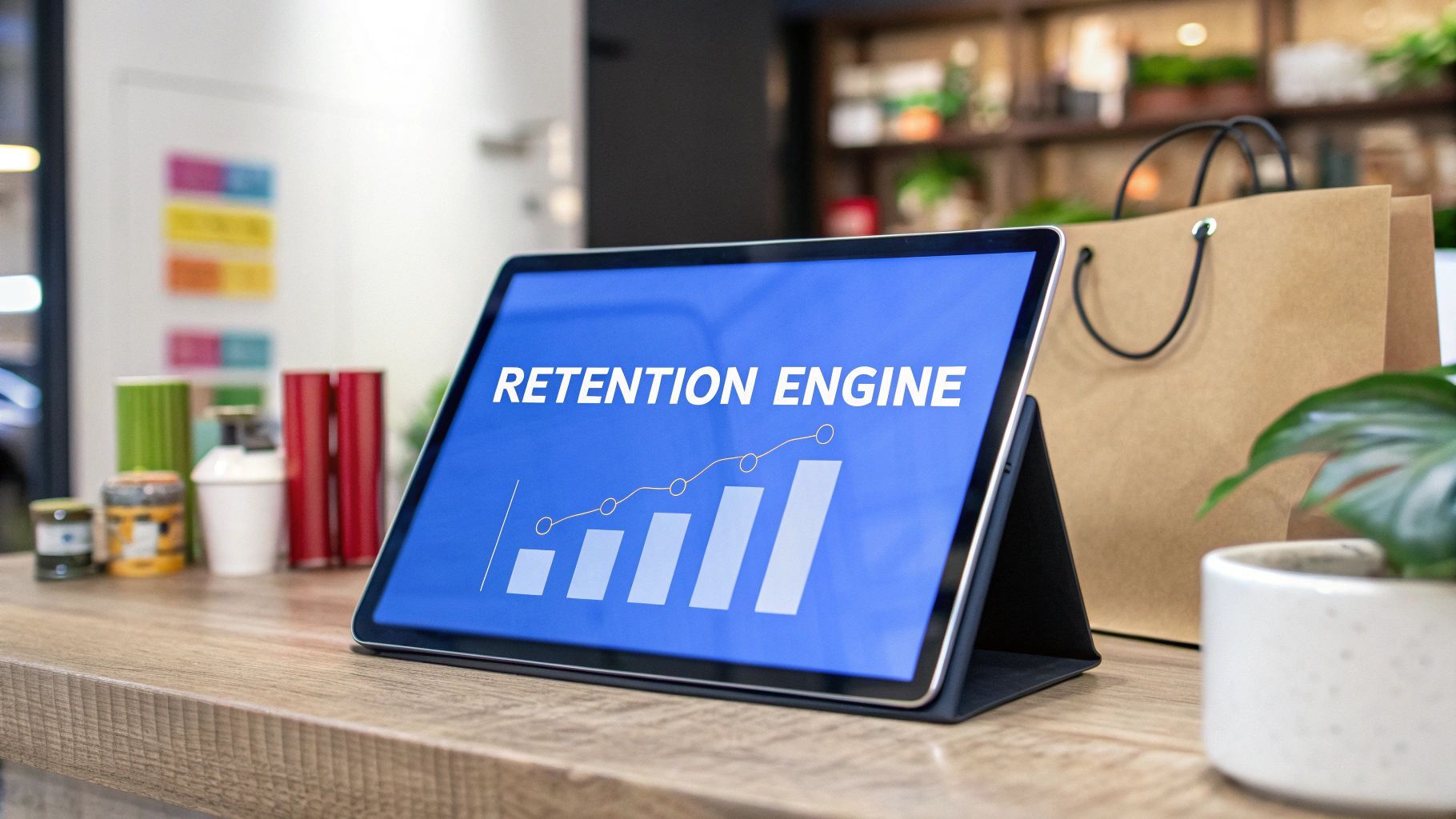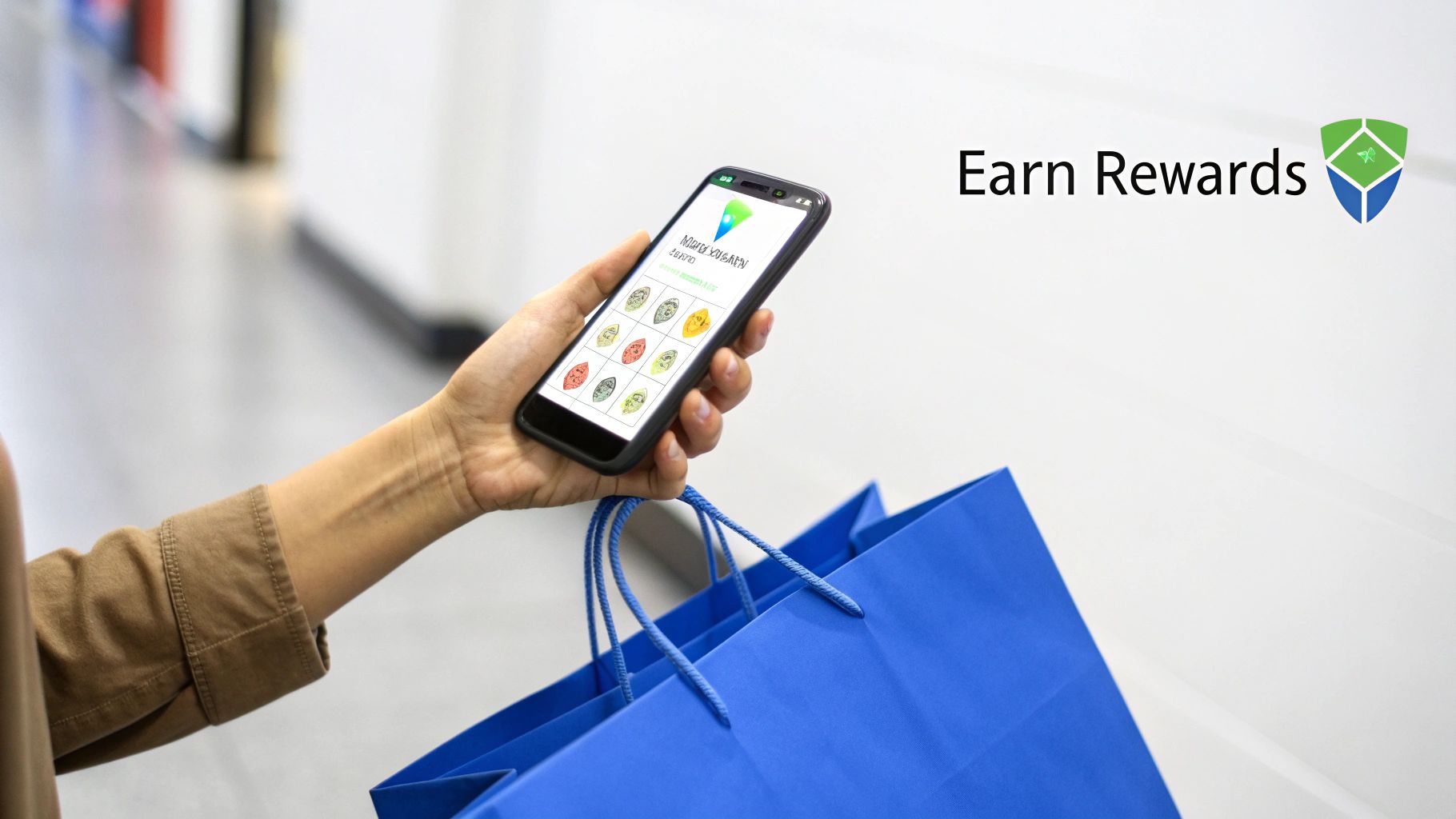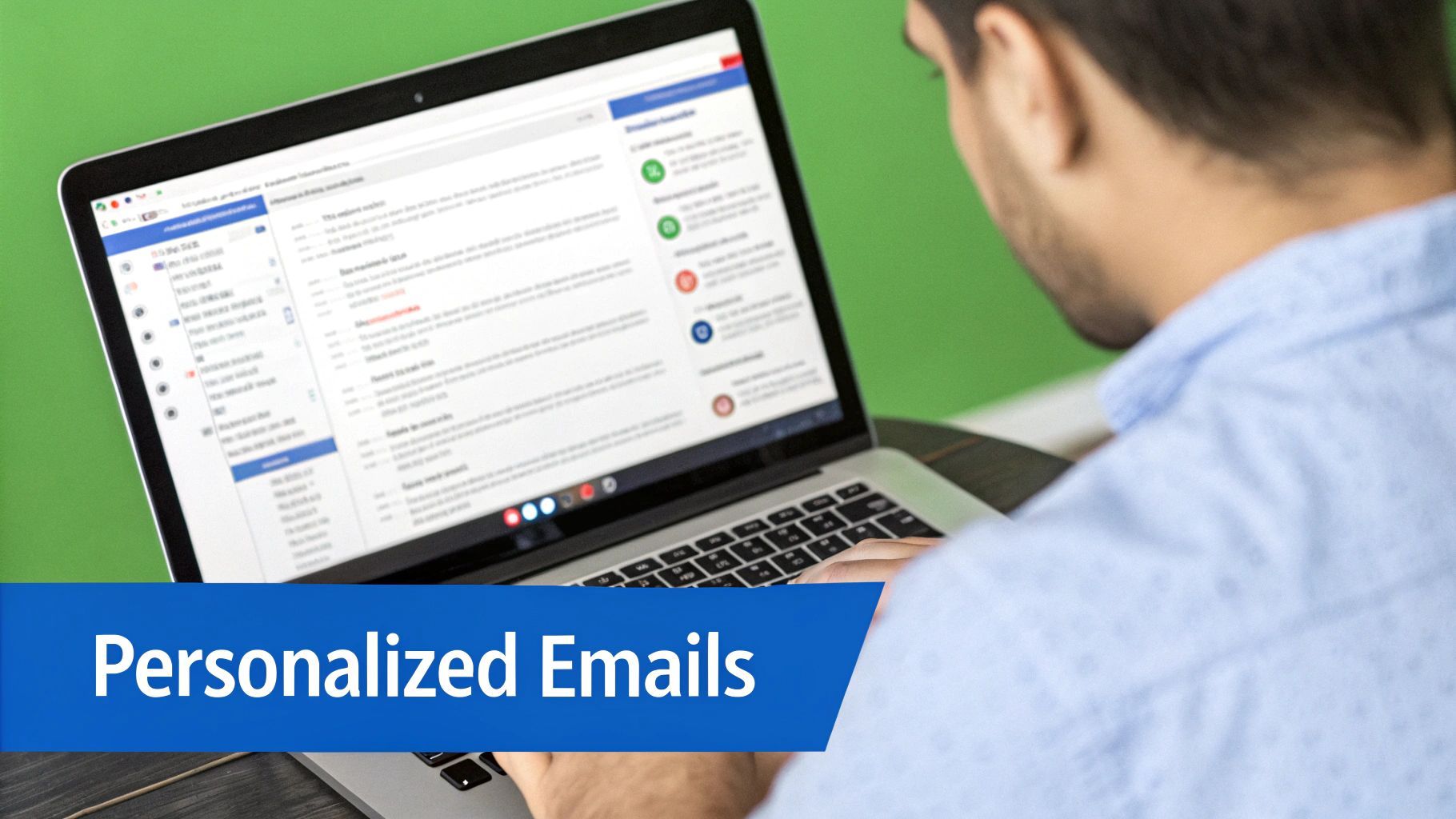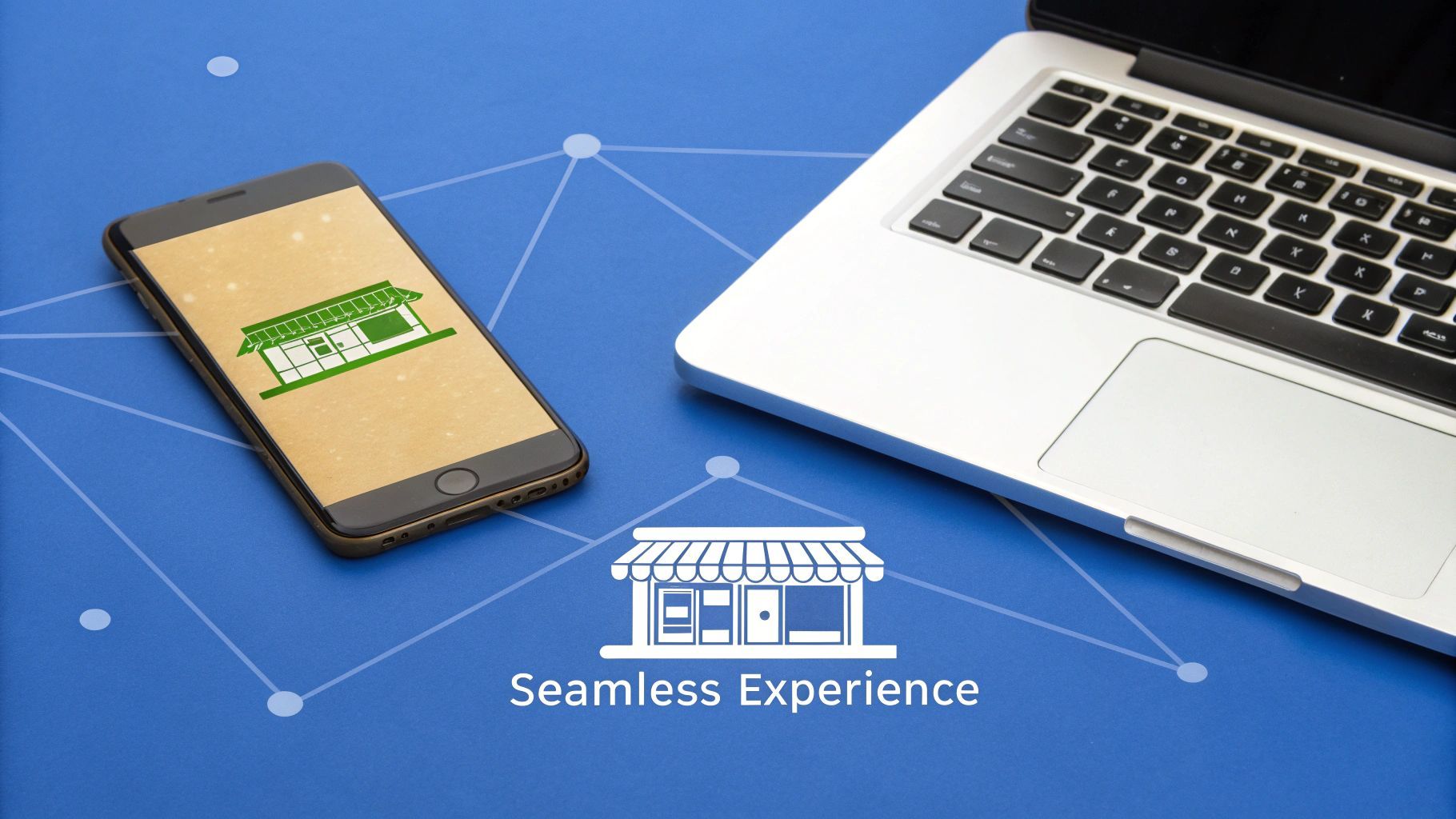
8 Strategies for Ecommerce Customer Retention in 2025
Discuss with AI
Get instant insights and ask questions about this topic with AI assistants.
💡 Pro tip: All options include context about this blog post. Feel free to modify the prompt to ask more specific questions!
In the competitive world of online retail, acquiring new customers is only half the battle. True, sustainable growth is built on the foundation of repeat business. The cost of acquiring a new customer can be five times more than retaining an existing one, making a strong focus on ecommerce customer retention not just a smart strategy, but an economic necessity. Happy, loyal customers spend more, purchase more often, and become powerful advocates for your brand. They are the bedrock of predictable revenue and long-term profitability.
This article moves beyond generic advice to provide a deep dive into 8 powerful, actionable strategies that can transform one-time buyers into lifelong fans. Forget surface-level tips; we will explore the specific tactics that drive results. You will learn how to implement everything from sophisticated rewards programs and highly personalized email campaigns to effective win-back strategies that reignite customer interest.
We will provide detailed implementation steps, real-world examples, and fresh perspectives to help you build a robust retention engine. The goal is to equip you with the tools needed to foster genuine brand loyalty, ensuring your business thrives not just today, but well into the future. Let’s get started.
A loyalty program is a structured incentive system designed to encourage repeat business. It rewards customers for making purchases and engaging with your brand, creating a powerful cycle of value exchange that is fundamental to ecommerce customer retention. By offering points, credits, or exclusive perks, you give customers a compelling, tangible reason to choose your store over a competitor.
This strategy moves the customer relationship beyond simple transactions into a long-term partnership. When executed well, it makes customers feel valued and recognized for their business. Programs like Sephora's Beauty Insider, which has over 25 million members, and Starbucks Rewards, responsible for a significant portion of their sales, demonstrate the immense power of a well-structured loyalty system. These programs foster an emotional connection and a sense of belonging.

To launch an effective loyalty program, focus on simplicity and value. Customers are more likely to participate if the rules are clear and the rewards are attainable and desirable.
- Keep it Simple: Ensure the earning and redemption process is straightforward. A "spend $1, earn 1 point" model is easy to understand. Clearly display point balances in customer accounts and on product pages.
- Offer Varied Rewards: Go beyond simple discounts. Offer free products, early access to new collections, free shipping upgrades, or exclusive access to members-only content. This variety caters to different customer motivations.
- Personalize the Experience: Use customer data to tailor rewards. For instance, if a customer frequently buys a specific product category, offer them bonus points or exclusive discounts on related items.
- Communicate Consistently: Regularly remind customers of their point balances and the rewards they can claim via email or on-site notifications. This keeps the program top-of-mind and encourages redemption.
By making your customers feel like insiders, you transform one-time buyers into loyal advocates, a cornerstone of successful ecommerce customer retention.
Personalized email marketing moves beyond generic, one-size-fits-all newsletters to deliver targeted communications based on customer data, behavior, and preferences. It’s about sending the right message to the right person at the right time. This strategy transforms your inbox from a broadcast channel into a powerful tool for building one-to-one relationships, a key driver for ecommerce customer retention. By leveraging what you know about your customers, you can create individualized experiences that feel relevant and valuable.
This approach makes customers feel seen and understood, not just as another number on a list. When an email contains product recommendations based on past purchases or offers tied to their browsing history, it demonstrates that you are paying attention. Industry leaders like Amazon have mastered this, with their recommendation algorithms driving a significant portion of sales. Similarly, Netflix's content suggestions and Spotify's weekly personalized playlists show how tailoring content to individual tastes fosters deep engagement and loyalty.

To effectively implement personalized email campaigns, you need to leverage customer data strategically. Start with simple personalization and gradually add layers of complexity as you gather more insights.
- Segment Your Audience: Group customers based on lifecycle stage (new customers, repeat buyers, at-risk customers), purchase history, or browsing behavior. This allows you to send highly relevant content to each segment.
- Use Dynamic Content: Incorporate personalization tokens like the customer's first name. Go further by dynamically inserting product recommendations based on their past purchases or recently viewed items directly into the email body.
- Automate Triggered Emails: Set up automated workflows for key customer actions. This includes welcome series for new subscribers, abandoned cart reminders, and post-purchase follow-ups that can request reviews or suggest complementary products.
- Optimize for Mobile: With over half of all emails opened on mobile devices, ensure your templates are responsive. Test your emails on various screen sizes to guarantee a seamless experience for every user.
- Expand Beyond Email: For even more direct and personal engagement, consider integrating other channels. Explore how retention marketing with WhatsApp can complement your email strategy for a multi-channel approach.
By personalizing your email communications, you show customers you understand their needs, building a strong foundation for lasting ecommerce customer retention.
A subscription or membership model is a powerful business strategy where customers pay a recurring fee to receive products, services, or exclusive benefits on a regular basis. This approach transforms one-time purchases into predictable, recurring revenue, creating an incredible foundation for long-term ecommerce customer retention. By delivering consistent value through convenience, cost savings, or exclusive access, you build a locked-in customer base that relies on your brand.
This model fundamentally shifts the customer relationship from transactional to ongoing. Instead of constantly fighting to win a customer back for their next purchase, the sale is automated. Pioneers like Dollar Shave Club, with its convenient razor deliveries, and Amazon Prime, with its ecosystem of benefits, have demonstrated how subscriptions can become an indispensable part of a customer's lifestyle. It fosters deep loyalty by integrating your brand directly into their routine.

To successfully launch a subscription model, the perceived value must consistently outweigh the recurring cost. Focus on flexibility and continuous improvement to keep subscribers engaged and happy.
- Offer Flexibility and Control: Empower customers by allowing them to easily adjust subscription frequencies, swap products, or pause deliveries. Programs like Chewy's Autoship excel at this, giving pet owners full control over their recurring orders.
- Communicate a Clear Value Proposition: Be explicit about the benefits. Whether it's "save 15% on every order," "never run out of coffee again," or "access to members-only products," the reason to subscribe should be compelling and easy to understand.
- Create a Strong Onboarding Sequence: The first few weeks are critical. Use a targeted email or SMS sequence to welcome new members, explain how to manage their subscription, highlight key benefits, and encourage early engagement to solidify the relationship.
- Continuously Gather Feedback: Proactively survey your members to understand what they love and what could be improved. Use this feedback to evolve your offerings, add new perks, and ensure the subscription experience remains fresh and valuable over time.
By building a membership or subscription, you create a dedicated community around your products, turning customers into long-term partners and securing a stable future for your brand.
Exceptional customer service is a cornerstone of ecommerce customer retention, transforming routine problem-solving into memorable, positive interactions. It goes beyond merely answering questions; it involves proactively anticipating customer needs, offering multiple accessible communication channels, and empowering support agents to delight customers. This approach turns a potential point of friction into a powerful opportunity to build trust and emotional connection with your brand.
When customers feel heard, respected, and genuinely cared for, they are far more likely to return. Legendary examples like Zappos, known for its customer-centric culture, and Chewy, which famously sends handwritten notes and even flowers to grieving pet owners, show how service can become a primary brand differentiator. These companies understand that a single, outstanding support experience can create a customer for life, proving that investing in service quality yields significant returns.

To elevate your support from functional to exceptional, focus on empowerment, training, and continuous improvement. Building a strong service framework is key to consistently exceeding customer expectations.
- Empower Your Frontline Team: Give your support agents the authority to resolve issues on the first contact without needing to escalate. This includes offering refunds, store credits, or other solutions that make the customer happy, demonstrating trust in both your employees and your customers.
- Invest in Comprehensive Training: Equip your staff with deep product knowledge and soft skills like empathy and active listening. A well-trained agent can handle complex issues with confidence and turn a negative situation into a positive one.
- Use Interactions to Exceed Expectations: View every support ticket as a chance to build a relationship. Follow up after a problem is solved to ensure satisfaction, or include a small, unexpected gift in a replacement shipment. For more ideas, you can explore detailed customer service best practices on spurnow.com.
- Implement a Feedback Loop: Actively collect feedback after every service interaction using surveys like CSAT or NPS. Use this data to identify areas for improvement, recognize top-performing agents, and refine your overall support strategy.
By treating customer service as a core business function rather than a cost center, you can build a reputation for reliability and care that becomes a powerful driver for ecommerce customer retention.
Retargeting is a powerful digital advertising strategy designed to re-engage users who have visited your site but left without converting. By using tracking pixels and cookies, you can serve targeted ads to these past visitors across other websites and social media platforms, keeping your brand top-of-mind and nudging them back toward purchase. This tactic is a cornerstone of modern ecommerce customer retention because it specifically targets an audience already familiar with your products.
This approach effectively bridges the gap between initial interest and final conversion. Instead of trying to attract cold traffic, you are communicating with a warm audience that has already shown intent. Platforms like Facebook with its Dynamic Product Ads and Google Ads' remarketing capabilities have made this highly accessible. They allow you to show previous visitors the exact products they viewed, creating a highly personalized and relevant advertising experience that encourages them to complete their purchase.
To maximize your return on ad spend, a strategic and segmented approach to retargeting is essential. Avoid generic ads and focus on tailored messaging that resonates with specific user behaviors.
- Segment Your Audiences: Don't treat all visitors the same. Create different audience segments based on behavior, such as cart abandoners, specific product page viewers, or lapsed customers. Tailor ad creative and offers for each group.
- Use Dynamic Creative: Implement dynamic ads that automatically show users the products they previously viewed or added to their cart. This high level of personalization significantly increases click-through rates and conversions.
- Implement Sequential Messaging: Tell a story with your ads. Show a sequence of different messages or offers over time to nurture the user back to your store, rather than showing the same ad repeatedly which can lead to ad fatigue.
- Exclude Recent Converters: To avoid wasting ad spend and annoying loyal customers, make sure to set up exclusion lists for users who have recently made a purchase. This simple step improves campaign efficiency and customer experience.
By strategically reminding potential customers of what they left behind, you can effectively recover lost sales and strengthen your ecommerce customer retention efforts.
User-generated content (UGC) is a powerful strategy that turns customers into brand advocates by encouraging them to create and share content related to your products. This includes everything from reviews and unboxing videos to social media posts and photos. Building on this, you can foster a community where customers connect, share experiences, and feel a sense of belonging to your brand.
This approach transforms marketing from a monologue into a conversation, creating authentic social proof that new buyers trust far more than traditional advertising. Brands like GoPro, which built its marketing almost entirely on customer-shot adventure videos, and Glossier, which uses customer photos extensively, show how UGC can build an engaged and loyal following. This method is a cornerstone of modern ecommerce customer retention, as it makes customers feel like co-creators of the brand story.
To effectively leverage UGC and build a community, you must empower your customers and make participation both easy and rewarding. Focus on creating an environment where sharing feels natural and valuable.
- Make Sharing Seamless: Integrate sharing options directly on product pages and post-purchase communications. Use a unique, memorable hashtag for social media campaigns to easily track and collect content.
- Incentivize Participation: Run contests or offer rewards for the best content. Featuring customers on your official social media pages or website is a powerful, non-monetary incentive that provides recognition.
- Showcase Customer Content: Actively display user-generated photos and reviews on your product pages, homepage, and in marketing emails. This not only provides social proof but also encourages others to contribute.
- Engage and Moderate: Respond to customer posts, comments, and reviews to show you are listening. Establish clear guidelines for your community spaces to ensure interactions remain positive and constructive. For more ideas, you can learn more about community building strategies on spurnow.com.
By creating a vibrant community around your brand, you give customers more reasons to stay than just the products themselves, significantly boosting long-term loyalty and retention.
An omnichannel customer experience is an integrated, unified approach that ensures seamless and consistent interactions across every touchpoint. This strategy breaks down the silos between your online store, mobile app, social media, and physical locations, allowing customers to move fluidly between channels without losing context or continuity. It is a cornerstone of modern ecommerce customer retention, as it centers the entire brand experience around the customer's journey, not the company's internal divisions.
This approach treats all channels as part of a single, cohesive ecosystem. When a customer can start a purchase on their laptop, check details on their mobile app, and complete the transaction in-store, they experience a frictionless journey that builds trust and convenience. Industry leaders like Nike exemplify this with a unified membership that syncs across their app, website, and retail stores, providing personalized recommendations and a consistent brand world. This level of integration makes staying with the brand the easiest and most rewarding option.
To build a true omnichannel experience, you must invest in technology and processes that unify customer data and create cross-channel functionalities. The goal is to make every interaction, regardless of platform, feel like a continuation of the same conversation.
- Unify Customer Profiles: Invest in a robust Customer Data Platform (CDP) to create a single, 360-degree view of each customer. This allows you to track interactions and preferences across all channels for deep personalization.
- Implement Cross-Channel Features: Offer practical integrations like "buy online, pick up in store" (BOPIS), "browse in-store, buy online," and a universal shopping cart that syncs across devices.
- Ensure Information Consistency: Your product information, pricing, and promotions must be identical across all channels. Inconsistencies create confusion and erode customer trust, undermining your retention efforts.
- Train Your Teams: Equip all customer-facing staff, both online and in-store, with the tools and training to access and use customer data. A support agent should see a customer's recent in-store purchase, just as a retail associate should see their online wishlist.
By creating a seamless, interconnected brand universe, you remove friction and make it effortless for customers to remain loyal, a critical component for achieving long-term ecommerce customer retention.
A win-back campaign is a targeted marketing strategy aimed at reconnecting with inactive or lapsed customers. It uses personalized communication and compelling offers to rekindle their interest and bring them back into the active customer fold, a crucial tactic for sustainable ecommerce customer retention. Instead of letting past buyers fade away, you proactively remind them of the value your brand offers.
This approach acknowledges that acquiring a new customer is significantly more expensive than reactivating an existing one. By identifying and segmenting inactive users, you can deploy tailored messages that address potential reasons for their departure. Successful examples include Spotify's personalized "Come Back" playlists and Grammarly's "We miss you" emails that offer new product insights, demonstrating how to re-engage users by reminding them of the unique value they are missing.
An effective win-back campaign goes beyond a simple "We miss you" email. It requires strategic segmentation and a genuine value proposition to successfully reactivate customers.
- Segment Your Inactive List: Don't treat all lapsed customers the same. Group them by their last purchase date (e.g., 60, 90, 180 days ago), purchase history, or engagement level. This allows for more relevant and potent messaging.
- Use Emotional and Nostalgic Appeals: Remind them what they loved about your brand. Your message could reference a past purchase they enjoyed or highlight how your products have evolved since their last visit.
- Offer Irresistible Value: While a discount can work, consider offering something more exclusive, like a free gift with their next purchase, early access to a new product, or a substantial loyalty point bonus. The goal is to make the offer too good to ignore.
- Simplify the Return Journey: Ensure the call-to-action is clear and leads directly to a user-friendly experience. Pre-applying a discount code at checkout or leading them to a curated landing page can significantly reduce friction.
By strategically re-engaging past customers, you not only recover lost revenue but also strengthen your brand's position and improve overall ecommerce customer retention metrics.
Strategy Implementation Complexity 🔄 Resource Requirements ⚡ Expected Outcomes 📊 Ideal Use Cases 💡 Key Advantages ⭐ Loyalty Points and Rewards Programs High - involves system integration and ongoing management High - technology, staff, and maintenance Increased customer lifetime value, repeat purchases Brands aiming to boost loyalty and repeat sales Strengthens emotional connection; reduces price sensitivity Personalized Email Marketing Campaigns Moderate - requires data integration and content creation Moderate - tools for segmentation and automation High ROI, improved open and click rates Businesses focusing on precise customer targeting Cost-effective; detailed performance analytics Subscription and Membership Models High - requires billing systems and retention focus High - onboarding, management, and customer support Predictable recurring revenue and higher lifetime value Products/services suited to recurring use Stable revenue; lower acquisition costs over time Exceptional Customer Service and Support High - multi-channel and staffing intensive High - trained staff and support tech Increased retention, positive word-of-mouth Customer-centric brands prioritizing experience Builds trust and differentiation in competitive markets Retargeting and Remarketing Campaigns Moderate to High - technical tracking and ad management Moderate - ad budget and platform tools Higher conversion rates vs. regular ads Ecommerce and digital businesses targeting warm leads Efficient warm audience targeting; measurable impact User-Generated Content and Community Building Moderate - requires community management and moderation Moderate - engagement and content curation Higher engagement and authentic social proof Brands leveraging social engagement and advocacy Free content creation; strong emotional connection Omnichannel Customer Experience Very High - requires unified data and system integration Very High - infrastructure and staff training Increased retention, satisfaction, and lifetime value Retailers and service providers with multiple channels Seamless, consistent customer journey across touchpoints Win-Back and Re-engagement Campaigns Moderate - automated triggers and personalized messaging Moderate - content creation and segmentation Recover lapsed customers; improved conversion rates Businesses with notable inactive customer segments Cost-effective reactivation; insights on churn reasons
Navigating the landscape of ecommerce customer retention can feel like juggling multiple, distinct initiatives. We've explored a powerful arsenal of strategies, from building robust loyalty programs and launching hyper-personalized email campaigns to leveraging the consistency of an omnichannel experience and the targeted precision of win-back campaigns. However, the true mastery of customer retention doesn't lie in executing these tactics in isolation. It's about weaving them together into a single, cohesive, and customer-centric ecosystem.
Think of each strategy as a thread. A single thread is useful, but when woven together, they create a strong, resilient fabric. Your goal is to build this fabric of loyalty around every customer. The data from your rewards program shouldn't just live in a silo; it should fuel the personalization of your email marketing and inform the timing of your retargeting ads. An exceptional customer service interaction is more than just a resolved ticket; it's a prime opportunity to request user-generated content or gently nudge a happy customer toward your subscription model.
To move from a collection of tactics to an integrated system, you must focus on the flow of data and experience between each touchpoint. A customer shouldn't feel like they are interacting with your marketing team, then your support team, then your social media team. They should feel like they are interacting with your brand.
Consider this integrated flow:
- Data Synergy: A customer’s purchase history (essential for retention) informs your personalized email campaigns with product recommendations. If they haven't purchased in 60 days, this data automatically triggers a win-back campaign.
- Experience Continuity: A support query initiated on your website's live chat can be followed up via SMS, creating a seamless omnichannel customer experience. This positive interaction can then be leveraged to encourage them to join your community or leave a review.
- Value Amplification: Members of your subscription program receive exclusive early access to sales, an offer promoted through targeted retargeting ads and reinforced via a personalized email, making their membership feel exceptionally valuable.
Ultimately, achieving superior ecommerce customer retention is about shifting your perspective from transactional to relational. It’s a continuous, dynamic cycle of delivering value, listening to feedback, and optimizing the experience. When you successfully integrate these strategies, you stop simply selling products. You start building a community of brand advocates who not only return to purchase again and again but also become a powerful, organic marketing force for your business. This loyal customer base is the most stable foundation for sustainable, long-term growth, insulating your brand from market volatility and ever-increasing customer acquisition costs. By investing in the customers you already have, you are investing in the very future of your brand.
Ready to transform your retention strategies from isolated tactics into a powerful, automated ecosystem? See how Spur unifies your customer conversations across channels like SMS, email, and social media, empowering you to deliver the personalized, real-time engagement that builds lasting loyalty. Explore Spur's retention-focused communication tools today.
